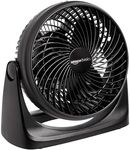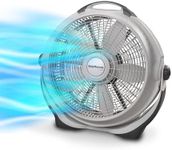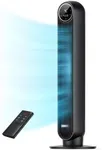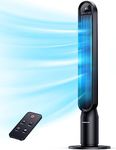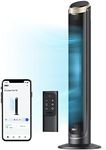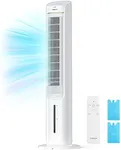Buying Guide for the Best Cooling Fans
When it comes to picking the right cooling fan, it's important to consider several key specifications to ensure you get the best performance and comfort for your needs. Cooling fans come in various types and sizes, and understanding these specifications will help you make an informed decision. Whether you're looking for a fan to cool down your room, your computer, or any other space, knowing what to look for will make the process much easier.Fan SizeFan size refers to the diameter of the fan blades and is usually measured in inches or millimeters. This spec is important because it affects the amount of air the fan can move. Larger fans can move more air and are generally quieter, making them ideal for larger rooms or spaces. Smaller fans are more compact and can be used in tighter spaces or for personal cooling. To pick the right size, consider the space you need to cool and how much airflow you require. For a large room, a fan with a diameter of 16 inches or more is suitable, while for a desk or small area, a fan with a diameter of 6 to 12 inches may be sufficient.
Airflow (CFM)Airflow is measured in cubic feet per minute (CFM) and indicates how much air the fan can move. This spec is crucial because it directly impacts the fan's cooling efficiency. Higher CFM values mean more air movement and better cooling. For general room cooling, look for fans with a CFM rating of at least 1,000. For personal or desk fans, a lower CFM of around 200-500 may be adequate. Choose a fan with a CFM rating that matches the size of the space you need to cool and your personal comfort preferences.
Noise LevelNoise level is measured in decibels (dB) and indicates how loud the fan will be when in operation. This spec is important for maintaining a comfortable environment, especially if you plan to use the fan in a bedroom or office. Fans with lower dB ratings are quieter and more suitable for noise-sensitive areas. Typically, a noise level below 50 dB is considered quiet. If you need a fan for a bedroom or a quiet workspace, look for models with noise levels under 40 dB. For less noise-sensitive areas, higher noise levels may be acceptable.
Speed SettingsSpeed settings refer to the number of different speeds at which the fan can operate. This spec is important because it allows you to adjust the airflow to your comfort level. Most fans come with at least three speed settings: low, medium, and high. Some advanced models may offer more precise control with additional speed options. To pick the right fan, consider how much control you want over the airflow. If you need flexibility to adjust the cooling intensity, choose a fan with multiple speed settings.
OscillationOscillation refers to the fan's ability to rotate from side to side, distributing air more evenly throughout the room. This spec is important for ensuring that the entire space receives adequate airflow. Fans with oscillation can cover a wider area and are ideal for larger rooms or shared spaces. If you need to cool a specific spot, a non-oscillating fan may be sufficient. For general room cooling, look for fans with an oscillation feature to ensure even air distribution.
Power ConsumptionPower consumption is measured in watts and indicates how much electricity the fan uses. This spec is important for understanding the fan's energy efficiency and its impact on your electricity bill. Lower wattage fans consume less power and are more energy-efficient, making them ideal for long-term use. To pick the right fan, consider how often you will use it and your energy efficiency preferences. For frequent use, choose a fan with lower power consumption to save on energy costs.
Build Quality and DurabilityBuild quality and durability refer to the materials and construction of the fan. This spec is important for ensuring the fan's longevity and reliability. Fans made with high-quality materials, such as metal or sturdy plastic, are more durable and can withstand regular use. To pick the right fan, consider where and how you will use it. For heavy-duty or outdoor use, choose a fan with robust build quality. For indoor or occasional use, a fan with standard build quality may be sufficient.
